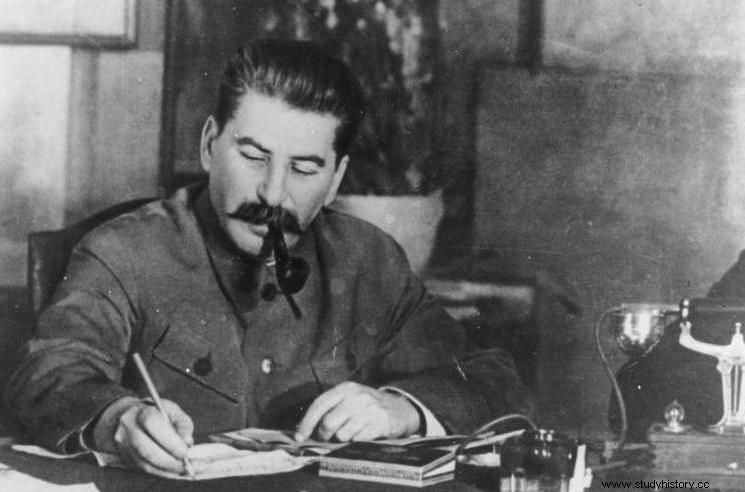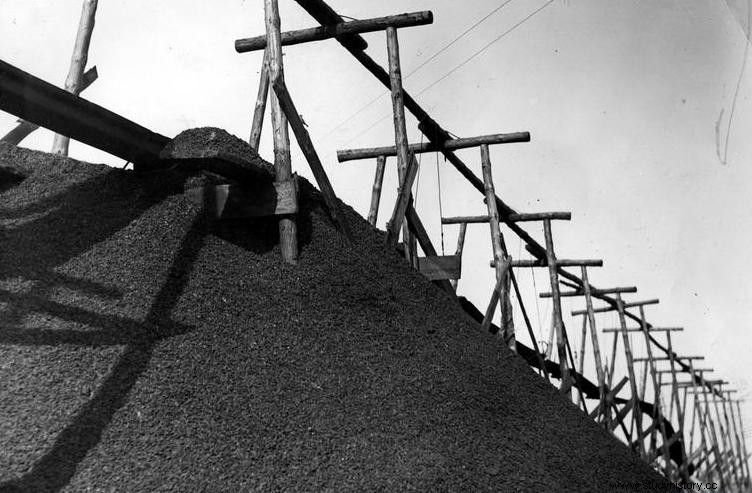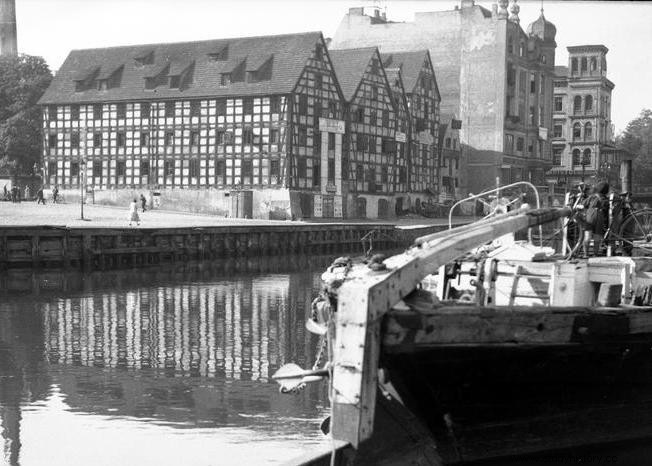Thousands of cattle driven in large herds to the Soviet Union. Hundreds of railway trains unloaded with industrial devices heading towards our eastern border. Peasants pillaged by Soviet soldiers. This was the liberation of Poland by the "brotherly" Red Army.
At the beginning of 1945, reports on the gains of war began to flow to Moscow from the territories of north-western Poland and eastern Germany occupied by the Red Army. They informed about industrial plants, mines, etc., which fell into the hands of Soviet soldiers almost intact.

A Bolshevik on a German propaganda poster from 1943. He will steal what he does not destroy (source:public domain).
Georgy Zhukov himself reported to Stalin that his troops had captured all factories, incl. in Łódź, Tomaszów, Radom, Bydgoszcz and other smaller towns. The Soviet marshal enjoyed the seizure of a large number of sugar factories and distilleries.
This industry was located in pre-war Poland and on German lands, granted to us as compensation for the lost Borderlands. So it seemed natural that it would be taken over by the Polish state, the more so since we had been a member of the anti-Nazi coalition since the beginning of the war, and the Polish Army also fought alongside the Soviets.

Marshal Georgy Zhukov (left) was very pleased with the seizure of many sugar factories and distilleries in Poland (source:public domain).
Nothing could be more wrong. The Soviet dictator made a decision that most clearly shows the nature of our "liberation". He dealt with conquered territory and ordered the dismantling of all industrial facilities. A Special Committee, headed by Georgy Malenkov, was established for this purpose. Its task was to coordinate the export of war goods and distribute them within the territory of the USSR.
How did the "trophic otriads" come about?
On January 10, 1945, the Council of People's Commissars issued an ordinance regulating the methods of dealing with war gains. This sanctioned the division of powers between the various organs of Soviet power in the occupied territories. Thus, the army was to confiscate, dismantle and secure the spoils, and then hand them over to the appropriate civilian representatives of the people's commissariats. The task of the latter was to organize the export of the captured devices to the Soviet Union.
Virtually all things having any material value were subject to export . Bogdan Musiał in his book "Stalin's War ..." quotes an order signed by Colonel General Nikolai Bulganin, which he describes as war gains:
(...) plants, estates, mansions, warehouses, granaries, stores with all kinds of assortment, agricultural machinery, food, fuel, feed, cattle, abandoned farm equipment household goods and other items that our troops captured in cities, villages and industrial centers located in enemy territory.
In order to cope with such a great logistic challenge as the export of a huge amount of goods, special "trophic otriads" were created. They were of two kinds. The first, numbering 500 people, were the so-called working battalions. Smaller, 50 people each, formed groups of cattle herders. The total number of members of the "trophy" commandos is estimated at around 100,000. people.
The Red Army releases ... Silesian coal
Soon a large-scale plunder began and the "trophy" troops began to confiscate everything they could get their hands on. From April 1 to June 1, 1945, the Soviets intended to deport 975,000 people from Upper Silesia. tons of coal, which was then a raw material of strategic importance.
From June 1, the planned daily output of Silesian mines, working under Soviet supervision, was to amount to 26 thousand. tone. In order to accelerate the transport of this valuable raw material, it was planned to significantly expand the railway lines running through our country to the east.

Stalin's decision made the Red Army behave in Poland as in a conquered territory. The best proof of this was the planned plundering on a large scale (source:Bundesarchiv; lic. CC ASA 3.0).
A number of industrial plants have also been dismantled . For example, in Gliwice, the pipe rolling mill equipment was dismantled within 25 days. Next on the list were the steel mills in Bobrek near Bytom and Łabędy. In the latter, another rolling mill was dismantled.
The dismantling of the power plant was particularly disastrous for the economy in Silesia. This applied to the plants in Miechowice, Zabrze, Zdzieszowice, Mikulczyce, Blachownia Śląska and Chełmsko Śląski. As many as 834 wagons were needed to transport all the equipment from Miechowice. The plant was pulled down to the last screw. After the war, everything had to be rebuilt from scratch.
How did Toruń garbage trucks disappear?
While all the aforementioned places belonged to Germany before the war, at the beginning of March Stalin signed new regulations, this time concerning plants located in our pre-war territory.

Silesian coal was of particular importance for the Soviets. Only from April 1 to June 1, 1945, they planned to transport as many as 975,000 to the USSR. tons of black gold (source:public domain).
Industrial enterprises in Sosnowiec, Dąbrowa Górnicza, Częstochowa, Zgodzie, Chorzów, Siemianowice, Poznań, Bydgoszcz, Grudziądz, Toruń, Inowrocław, Włocławek, Chojnice, Łódź, Dziedzice, Oświęcim and Chorzów went under the knife, or rather under the hammer of the Soviet dismantling units.
30 large plants were to be transported from Bydgoszcz to the USSR. Like about 250 vessels that are part of the Bydgoszcz Canal flotilla. Grudziądz was literally stripped of industry, even that owned by small companies.

The scale of Soviet robberies in the occupied territories is evidenced, for example, by the fact that 30 large plants were to be transported from Bydgoszcz to the USSR. As well as about 250 vessels belonging to the Bydgoszcz Canal flotilla (source:public domain).
In Toruń, the equipment of the local mills was loaded onto 46 railway carriages, which resulted in a shortage of bread in the city. Our "liberators" confiscated most of the 4 million liters of spirit from the warehouses of Toruń's spirit plants . Even municipal utilities lost their garbage trucks.
Where was the Railway Security Service?
The Soviets attached particular importance to the dismantling of German synthetic fuel plants. It was mainly about large plants in Blachownia Śląska, which could ultimately produce 350 thousand. tons of fuel per year. The plant could be extremely valuable for the rebuilding Poland. The "Soviet-friendly" Polish government even sent a delegation to Moscow to abandon its requisitions.
Polish comrades, however, were sent away with nothing and almost 10,000 people went to the USSR. wagons unloaded with the equipment of the above-mentioned company. Even more, because almost 14 thousand. The wagons were needed to transport the synthetic petrol plants in Police.
It was similar with rail transport. In this case, the Soviets took whatever could be of use to them. The railway line, engine sheds, railroad cars, repair workshops, etc. were dismantled. About 5,500 km of railway lines have disappeared from the territory of today's Poland. For comparison, the total length of railway lines in Poland in 2010 was 22,046 km.
The Cherry Cow was an exception
Agriculture also did not escape the losses associated with the "liberation". Stalin personally signed the ordinances, pursuant to which huge herds of horses and cattle were banished from the present territory of Poland to the USSR . In total, by September 1, 1945, 506,000 people were confiscated. head of cattle, over 114 thousand. sheep and 206 thousand. horses.

Looting also affected agriculture. Only until September 1, 1945, the Soviets confiscated 506,000 in Poland. head of cattle, over 114 thousand. sheep and 206 thousand. horses. The picture shows a painting by Thomas Sidney Cooper (source:public domain).
Agricultural produce and their products were also subject to requisition. Already in February 1945, 72 thousand people were transported to the USSR. tons of sugar. More than 14,000 Jews were deported from the Toruń poviat alone. tons of grain, 20 thousand. tons of potatoes and 21 thousand. tons of fodder beet.
As if that was not enough, regardless of the Soviet plunder, the "Polish government" pledged to provide the "ally" with 150,000. tons of grain, 250 thousand. tons of potatoes, 100 thousand. tons of straw and 25 thousand. tons of meat.
Soviet version of FedEx
In addition to the robbery sponsored by the Soviet state, there was also a private szaber led by the Red Army. In order to introduce some sort of order, the People's Commissariat of Defense introduced special provisions regulating this practice at the end of 1944.
In their mind, model soldiers could send a trophy package once a month. Its weight depended on the degree. For privates it was 5 kg. Officers - as Antony Beevor stated in his book "Berlin 1945. The Fall" - they could send a package twice as large. No limits were applied to the generals and officers of Smiersz's units . There were times when senior officers sent home even whole wagons of prey.
And what were the most popular souvenirs? It was mainly food, clothes, shoes, radios, tableware, dishes, bedding, bicycles, watches, and even nails, glass and toilet seats . The scale of these exports was also huge.

Apart from the planned plunder, the robberies carried out by the Red Army soldiers were a real nightmare. They didn't even disdain toilet seats (source:public domain).
Catherine Merridale in the book "Ivan's War ." The Red Army 1939-1945 ”gives the example of Kursk. In January 1945, only 300 parcels were delivered to this city. By the end of May, their number amounted to 87,000. pieces. A warehouse was built near the station to protect the loot from the weather and a shelter for brigades unloading wagons and delivering parcels to recipients. And Kursk was just one of many such cities.
At a stall on market day…
Red Army soldiers looted their gains not only in Prussia, Silesia and Pomerania. Poles were also at risk of losing their private property. In Jeżów near Łódź, in October 1945, drunk Soviet soldiers robbed stalls during the market that was taking place. . When the Polish peasants resisted, the Soviets returned fire and used grenades.
The police and officers of the local security office intervened at that time. The Krasnoarmeys then barricaded themselves in a nearby building. The situation was brought under control only after the arrival of a senior Soviet officer. 17 people were killed then and several dozen were injured. There are more and more similar examples.
The scale of Soviet confiscation in pre-war Polish lands and the so-called the recovered lands was vast. According to Soviet data, only 1119 industrial enterprises were deported. Until January 1, 1948, 239 thousand people left our eastern border. wagons loaded with raw materials, machinery and other war booty. It is uncertain whether this is final data as the requisition documents have been destroyed.

Until January 1, 1948, 239 thousand people left our eastern border. wagons loaded with raw materials, machines and other war booty (source:public domain).
In 1946, Poles estimated the losses caused by Soviet looting at 375 million dollars and only those incurred in central Poland and the lost eastern territories. Including the former German territories, it was 2 billion USD 375 million according to the value of currencies from 1938. To this should be added the damage caused by the Red Army in Poland (not including the damage caused by hostilities!). Their amount was calculated at $ 292.5 million.
Even if we ignore the robberies in the "reclaimed territories," the total is over 667 million. In today's dollar value, this is anywhere from 11 to over 54 billion (depending on the calculator used). And yet the interest would have to be added…
Indeed, we had to pay dearly for the privilege of "liberation" by "fraternal" Soviet troops. Maybe it's time to ask your friends from the East for compensation?
